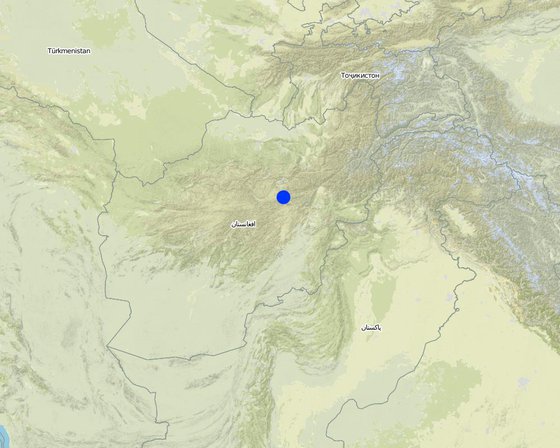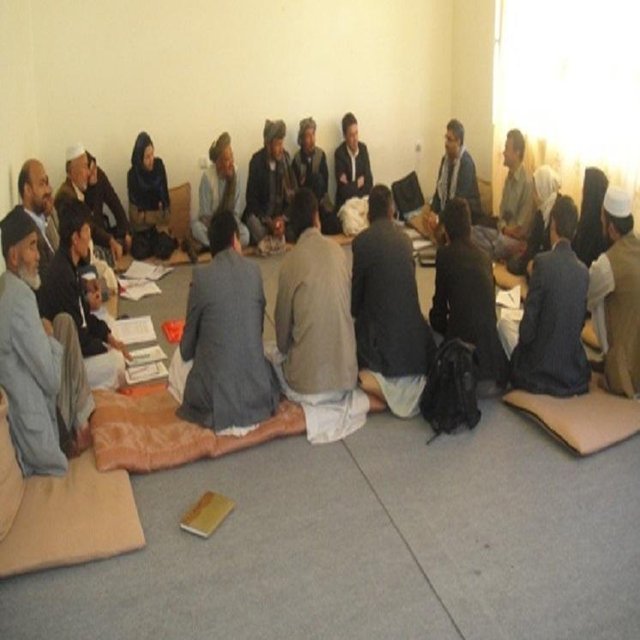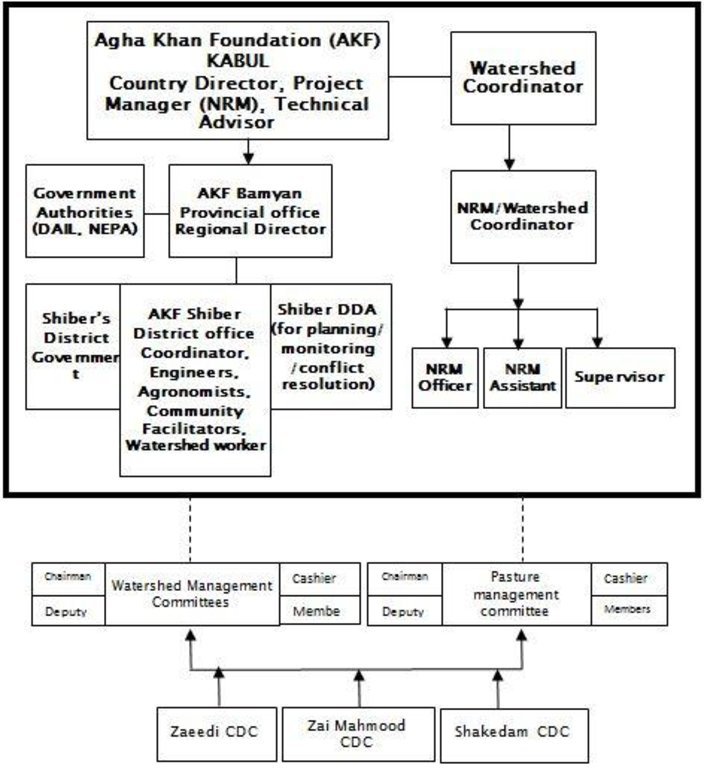Community-based Natural Resource Management
(อัฟกานิสถาน)
Tanzeem Manabae Tabiee Tawasut Mardum (Dari)
คำอธิบาย
An approach to community participation in the sustainable management of natural resources
The main objective of the intervention was to reduce the surface run-off and sediment flow from the selected degraded watershed, with soil and water conservation measures through community participation.
Agha Khan Foundation and representatives from the selected Community Development Councils (CDC) surveyed the area and discussed the main land use problems. On the basis of feasibility surveys, potential SLM technologies were identified and implemented. Contour lines were prepared with the help of an A-frame and lime. Several men from Zai Mahmood village were employed as daily wage workers for the technology implementation works. The land users used their own tools for trench excavation. Each worker excavated on an average one trench per day. The daily wage was 250 AFS/USD.
The project was executed over two years. In addition to the structural measures, training and exposure visits for watershed management committee and pasture committee members, reseeding of more areas, tree plantation campaigns and group-based women vegetable farming were realized. Women were employed for seed collection work with cash for work approach. The area was protected from grazing and shrub cutting pressure. Seeds of different fodder varieties and shrubs were also cultivated.
Since the realization of the project in 2008, soil and vegetation cover has improved, people’s knowledge about soil and water conservation has increased, flash floods have been controlled and discharge in the spring located below the watershed has increased by about 40%. AKF continues to support the target communities with community development and institution building. The water-shed work is sustained by a watershed and pasture management committee appointed by the people from three respective CDCs.
The Community-Based Natural Resource Management approach is documented by Sustainable Land Management Project implemented/HELVETAS Swiss Intercooperation which is funded by Swiss Agency for Development and Cooperation with close support and cooperation of the Agha Khan Foundation (AKF).
The watershed project was funded by AusAID. The Aga Khan Foundation (AKF) facilitated the implementation by the community. The project was implemented in Zai Mahmood mountain slope area in Zai Mahmood village, Shiber district, Bamyan Province. The village, located downstream from the site, experienced problems such as excessive surface runoff/flash floods, snow avalanches, soil erosion, lack of drinking water, lack of soil moisture at the site.
สถานที่

สถานที่: Bamyan center, Afghanistan, Zai Mahmood village, อัฟกานิสถาน
ตำแหน่งทางภูมิศาสตร์ของสถานที่ที่ถูกเลือ
วันที่ริเริ่ม: 2008
ปีที่สิ้นสุด: n.a.
ประเภทของแนวทาง
-
แบบดั้งเดิม/ แบบพื้นเมิอง
-
เป็นนวัตกรรมท้องถิ่นล่าสุด/ นวัตกรรมใหม่
-
ใช้โครงงานหรือแผนงานเป็นฐาน

Evaluation of the approach by WOCAT training participants with the help of land users (Madhav Dhakal)
แนวทางการดำเนินการและบรรยากาศการพัฒนาที่เอื้ออํานวย
เป้าหมายหรือวัตถุประสงค์หลักของแนวทาง
The Approach focused mainly on SLM with other activities (Disaster Risk Reduction, Pasture Improvement, Gender Equity, Income Generation)
Strengthen the capacity (organizational and technical), of the community to: restore their degraded lands, demonstrate multi-purpose soil and water conservation measures, reduce floods and snow avalanches, improve pastures, improve gender equity and the involvement of social disadvantaged groups, employment and income generation
The SLM Approach addressed the following problems: Lack of knowledge in terms of sustainable watershed management; poverty; drought; floods and avalanches
เงื่อนไขที่เอื้ออำนวยต่อการนำเอาเทคโนโลยีภายใต้แนวทางนี้ไปปฏิบัติใช้
เงื่อนไขที่เป็นอุปสรรคต่อการนำเอาเทคโนโลยีภายใต้แนวทางนี้ไปปฏิบัติใช้
-
บรรทัดฐานและค่านิยมทางสังคม วัฒนธรรม ศาสนา: Community-based management capacity was weak
Treatment through the SLM Approach: CDCs capacities were enhanced
-
การมีไว้ให้หรือการเข้าถึงแหล่งการเงินและบริการ: Community’s low economy
Treatment through the SLM Approach: AKF provided financial support; also there were contributions from the participating community
-
การจัดตั้งระดับองค์กร: Lack of organizational structures
Treatment through the SLM Approach: Watershed and pasture management committees formed
-
ความรู้เกี่ยวกับ SLM การเข้าถึงการสนับสนุนด้านเทคนิค: Lack of technical awareness
Treatment through the SLM Approach: AKF provided technical support
การมีส่วนร่วมและบทบาทของผู้มีส่วนได้เสีย
ผู้มีส่วนได้เสียที่เกี่ยวข้องในแนวทางนี้และบทบาท
| ผู้มีส่วนได้เสียหรือองค์กรที่นำไปปฏิบัติใช้มีส่วนเกี่ยวข้องกับแนวทางนี้อย่างไร |
ระบุผู้มีส่วนได้ส่วนเสีย |
อธิบายบทบาทของผู้มีส่วนได้ส่วนเสีย |
| ผู้ใช้ที่ดินระดับท้องถิ่นหรือชุมชนระดับท้องถิ่น |
|
|
| องค์กรที่ขึ้นอยู่กับชุมชน |
|
|
การเกี่ยวข้องของผู้ใช้ที่ดินระดับท้องถิ่นหรือชุมชนระดับท้องถิ่นในช่วงต่าง ๆ ของแนวทาง
ไม่มี
ไม่ลงมือ
จ่ายเงินหรือสนับสนุนจากภายนอก
ปฏิสัมพันธ์
ระดมกำลังด้วยตนเอง
การริเริ่มหรือการจูงใจ
Meetings and Workshops for men and women
การวางแผน
With CDC members, mainly men for watershed works
การดำเนินการ
Interactive, Cash for work, Contributions from communities as well
การติดตามตรวจสอบหรือการประเมินผล
Research
Analyzing technology performance and making adjustments if required
แผนผัง
The organization structure of the NRM project implemented in Zai Mahmood village, Shiber district, Bamyan, Afganistan

ผู้เขียน Agha Khan Foundation (AKF)
การตัดสินใจในการเลือกใช้เทคโนโลยี SLM
การตัดสินใจถูกทำโดย
-
ผู้ใช้ที่ดินเพียงผู้เดียว ( ริเริ่มด้วยตัวเอง)
-
ผู้ใช้ที่ดินเป็นผู้ตัดสินใจหลัก โดยการสนับสนุนจากผู้เชี่ยวชาญ SLM
-
ผู้ลงมือปฏิบัติที่เกี่ยวข้องทั้งหมดในฐานะที่เป็นส่วนรวมของแนวทาง
-
ผู้เชี่ยวชาญ SLM เป็นผู้ตัดสินใจหลัก ที่ติดตามให้คำปรึกษากับผู้ใช้ที่ดิน
-
ผู้เชี่ยวชาญ SLM เพียงผู้เดียว
-
นักการเมืองหรือผู้นำ
การตัดสินใจถูกตัดสินอยู่บนพื้นฐานของ
-
การประเมินความรู้ SLM ที่ได้ทำการบันทึกไว้เป็นอย่างดี (การใช้ข้อมูลในการตัดสินใจ)
-
สิ่งที่ค้นพบจากงานวิจัย
-
ประสบการณ์และความคิดเห็นส่วนตัว (ไม่ได้ลงบันทึกไว้)
การสนับสนุนด้านเทคนิค การสร้างขีดความสามารถ และการจัดการด้านความรู้
กิจกรรมหรือการบริการต่อจากนี้เป็นส่วนหนึ่งของแนวทาง
-
การสร้างขีดความสามารถ / การอบรม
-
การบริการให้คำแนะนำ
-
การเสริมความแข็งแกร่งให้กับสถาบัน (การพัฒนาองค์กร)
-
การติดตามตรวจสอบและประเมินผล
-
การวิจัย
การสร้างสมรรถภาพหรือการอบรม
การจัดอบรมถูกจัดขึ้นสำหรับผู้มีส่วนได้ส่วนเสียต่อไปนี้
-
ผู้ใช้ที่ดิน
-
เจ้าหน้าที่ภาคสนาม / ที่ปรึกษา
รูปแบบของการอบรม
-
กำลังดำเนินการ
-
เกษตรกรกับเกษตรกร
-
ใช้พื้นที่ทำการสาธิต
-
จัดการประชุมสู่สาธารณชน
-
จัดคอร์ส
หัวข้อที่อบรม
Vegetable farming for women; soil and water conservation; watershed management; pasture management. Training was mainly on-the-job, and awareness was raised through public meetings, site visits and demonstrations.
การบริการให้คำแนะนำ
การให้คำแนะนำถูกจัดขึ้น
-
ไปเยี่ยมชมสถานที่
-
ที่ศูนย์ถาวร
On-site visits by DAIL (Department of Agriculture, Irrigation and Livestock; Key elements: Pasture management, Site selection
Advisory service is quite adequate to ensure the continuation of land conservation activities; The government or other advisory service is quite adequate to ensure the continuation of land conservation activities although the staff turnover rate in government sector is high. DAIL Bamyan office has the technical capacity but not adequate financial resources.
การสร้างความแข็งแกร่งให้กับองค์กร
องค์กรถูกทำให้แข็งแกร่งขึ้นหรือจัดตั้งขึ้น
-
ไม่
-
ใช่ เล็กน้อย
-
ใช่ ปานกลาง
-
ใช่ อย่างมาก
อธิบายถึงสถาบัน บทบาทและความรับผิดชอบ สมาชิก เป็นต้น
ประเภทของการให้ความช่วยเหลือสนับสนุน
-
ด้านการเงิน
-
การสร้างขีดความสามารถ / การอบรม
-
อุปกรณ์
รายละเอียดเพิ่มเติม
CDCs and District Development Assembly (DDA) in terms of financial and capacity building of participating
การติดตามตรวจสอบและประเมินผล
bio-physical aspects were regular monitored by project staff, land users through measurements; indicators: Biomass before and after
technical aspects were ad hoc monitored by project staff, land users through observations; indicators: growth of saplings, shrubs and fodder grasses (alfalfa)
socio-cultural aspects were ad hoc monitored by project staff, land users through measurements; indicators: Water availablity, food security, income
economic / production aspects were regular monitored by project staff through measurements; indicators: fodder production, income
area treated aspects were ad hoc monitored by project staff through measurements; indicators: areas where technology was applied
no. of land users involved aspects were regular monitored by project staff, land users through measurements; indicators: CDCs and men and women involved
management of Approach aspects were regular monitored by project staff, government, land users through observations; indicators: area protected or not
There were few changes in the Approach as a result of monitoring and evaluation: Women has given some more chances for the participation but still there is long way to go. There were some technology refinements and adjustments in project management.
การวิจัย
การวิจัยกระทำกับหัวข้อต่อไปนี้
-
สังคมวิทยา
-
เศรษฐศาสตร์หรือการตลาด
-
นิเวศวิทยา
-
เทคโนโลยี
However there are no publications to verify that. Research was carried out on-farm
การสนับสนุนด้านการเงินและวัสดุอุปกรณ์
งบประมาณประจำปีสำหรับองค์ประกอบ SLM เป็นจำนวนดอลลาร์สหรัฐ
-
< 2,000
-
2,000-10,000
-
10,000-100,000
-
10,000-100,000
-
> 1,000,000
Precise annual budget: n.a.
Approach costs were met by the following donors: international: 50.0%; national non-government: 30.0%; local community / land user(s): 20.0%
การบริการหรือแรงจูงใจต่อจากนี้ได้ถูกจัดให้สำหรับผู้ใช้ที่ดิน
-
การสนับสนุนด้านการเงิน / วัสดุอุปกรณ์ให้แก่ผู้ใช้ที่ดิน
-
เงินสนับสนุนสำหรับปัจจัยการผลิต
-
เครดิต
-
แรงจูงใจหรือเครื่องมืออื่น ๆ
ผลกระทบและสรุปคำบอกกล่าว
ผลกระทบของแนวทาง
ไม่ใช่
ใช่ เล็กน้อย
ใช่ ปานกลาง
ใช่ อย่างมาก
ช่วยให้ผู้ใช้ที่ดินนำเอาเทคโนโลยี SLMไปใช้และบำรุงรักษาสภาพไว้ได้หรือไม่
Increased water and soil quality with more vegetation and reduction in floods
ทำให้กลุ่มด้อยโอกาสมีอำนาจทางสังคมและเศรษฐกิจหรือไม่
Through increased decision-making powers about natural resources by poor and marginalized members of the community.
Did other land users / projects adopt the Approach?
There is no spontaneous adoption.
แรงจูงใจหลักของผู้ใช้ที่ดินเพื่อที่จะนำ SLM ไปปฏิบัติใช้
-
Reduced flash floods & improved land productivity
ความยั่งยืนของกิจกรรมของแนวทาง
ผู้ใช้ปที่ดินสามารถทำให้สิ่งต่างๆ ที่ได้ปฏิบัติใช้โดยแนวทางนี้ยั่งยืนได้หรือไม่ (โดยไม่มีการสนับสนุนจากภายนอก)?
บทสรุปหรือบทเรียนที่ได้รับ
จุดแข็ง: มุมมองของผู้ใช้ที่ดิน
จุดแข็ง: ทัศนคติของผู้รวบรวมหรือวิทยากรคนอื่นๆ
-
Increase in vegetation cover
-
People knowledge regarding SWC improved
-
Increase in spring water
-
Flash flood controlled
-
Watershed and pasture management committees formed
จุดด้อย/ข้อเสีย/ความเสี่ยง: มุมมองของผู้ใช้ที่ดินแก้ไขปัญหาได้อย่างไร
จุดด้อย/ข้อเสีย/ความเสี่ยง: ทัศนคติของผู้รวบรวมหรือวิทยากรคนอื่นๆแก้ไขปัญหาได้อย่างไร
-
Disturbance in NRM / soil disturbance
Minimize the soil disturbance, and compact the excavated soil
-
Increase in mice
Compact the excavated soil, other control measures
-
Plant growth is slow due to high elevation
Choose adaptable species
-
No watershed benefit sharing mechanism in place
Benefit mechanism be developed in a participatory way and agreed by the land users and other stakeholders
การอ้างอิง
ผู้ตรวจสอบ
-
Deborah Niggli
-
Joana Eichenberger
วันที่จัดทำเอกสาร: 9 กุมภาพันธ์ 2016
การอัพเดทล่าสุด: 18 เมษายน 2019
วิทยากร
-
Helaluddin Musadiq (helal.musadiq@slmi.org.af) - ผู้เชี่ยวชาญ SLM
-
Sanjeev Bhuchar (sanjeev.bhuchar@helvetas.org) - ผู้เชี่ยวชาญ SLM
-
Madhav Dhakal (mdhakal@icimod.org) - ผู้เชี่ยวชาญ SLM
-
Ghulam Sakhi Ahmadi - ผู้เชี่ยวชาญ SLM
-
M. Altaf Jalil - ผู้เชี่ยวชาญ SLM
-
Marzia Hussaini - ผู้เชี่ยวชาญ SLM
-
Baqir Hussaini - ผู้เชี่ยวชาญ SLM
-
Jawad Wafa - ผู้เชี่ยวชาญ SLM
-
Asadullah Jawadi - ผู้เชี่ยวชาญ SLM
-
Alex Yagoo - ผู้เชี่ยวชาญ SLM
-
Muhammad Eqbal - ผู้เชี่ยวชาญ SLM
คำอธิบายฉบับเต็มในฐานข้อมูล WOCAT
การจัดทำเอกสารถูกทำโดย
องค์กร
- HELVETAS (Swiss Intercooperation)
โครงการ




